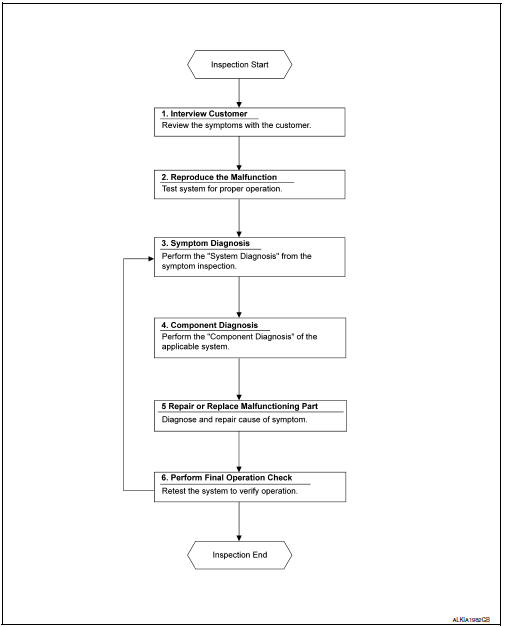Nissan Sentra Service Manual: Diagnosis and repair workflow
Work flow
Overall sequence

Detailed flow
1. Obtain information about symptom
Interview the customer to obtain as much information as possible about the conditions and environment under which the malfunction occurred.
>> GO TO 2.
2. Confirm concern
Check the malfunction on the vehicle that the customer describes.
Inspect the relation of the symptoms and the condition when the symptoms occur.
>> Go to 3.
3. Identify the malfunctioning system with symptom diagnosis
Use Symptom diagnosis from the symptom inspection result in step 2 and then identify where to start performing the diagnosis based on possible causes and symptoms.
>> GO TO 4.
4. Perform the component diagnosis of the applicable system
Perform the diagnosis with Component diagnosis of the applicable system.
>> GO TO 5.
5. Repair or replace the malfunctioning parts
Repair or replace the specified malfunctioning parts.
>> Go to 6.
6. Final check
Check that malfunctions are not reproduced when obtaining the malfunction information from the customer, referring to the symptom inspection result in step 2.
Are the malfunctions corrected? Yes >> inspection end.
No >> go to 3.
 Basic inspection
Basic inspection
...
 Inspection and adjustment
Inspection and adjustment
Additional service when replacing control unit
Additional service when replacing control unit : description
Memory reset procedure
Please observe the following instructions at confirming the moo ...
Other materials:
Seat belt warning system
Seat Belt Warning System Does Not Function
1.SEAT BELT WARNING LIGHT
Turn ignition switch ON.
Does the seat belt warning lamp come ON?
YES >> GO TO 2.
NO >> • Check 10A fuse [No. 8, located in the fuse block (J/B)].
Check seat belt buckle switch (driver seat)
Check ha ...
P0181 FTT Sensor
DTC Logic
DTC DETECTION LOGIC
DTC No.
CONSULT screen terms
(Trouble diagnosis content)
DTC detecting condition
Possible cause
P0181
FTT SENSOR
(Fuel temperature sensor ″A″
circuit range/performance)
A)
Rationally incorrect voltage from the
...
Precaution for work
When removing or disassembling each component, be careful not to damage
or deform it. If a component
may be subject to interference, be sure to protect it with a shop cloth.
When removing (disengaging) components with a screwdriver or similar
tool, be sure to wrap the component
with a ...
